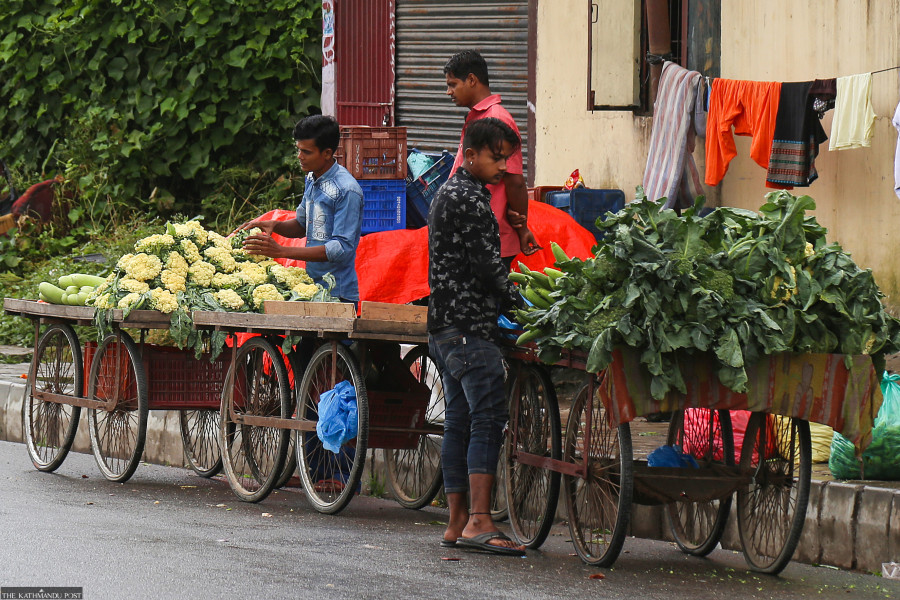Money
Vegetable prices soar due to heavy rains
Traders say prices will rise further as production has been affected in India and Nepal.
Krishana Prasain
While the fluctuation in vegetable prices is a recurring theme, this year’s post monsoon rainfall is showing its impact on major kitchen staples like onion and tomato, which has skyrocketed to Rs100 per kg in retail.
The sudden and extreme rainfall in the third week of October, about a month after the monsoon usually ends in Nepal, not only damaged the paddy fields that were ready for harvest but it has also impacted vegetable production leading to a price hike.
The unseasonal rainfall has already caused prices of common kitchen ingredients such as onion and tomato to soar. According to the Kalimati Fruits and Vegetable Market Development Board, the wholesale price of onion has jumped to Rs72 per kg from Rs60-70 and tomato has seen its wholesale value per kg spike to Rs90 from Rs40-45.
This means that consumers are paying Rs100 per kg for these kitchen staples and vegetable traders saying that prices could rise even further, up to Rs150 per kg.
Anil Basnet, founder and CEO of Metrotarkari, an online vegetable and fruit store, said that the price of onions imported from India had risen and the rainfall had also damaged the imported onions. “Traders are hiking the price to cover for the loss in goods,” said Basnet.
The impact of unseasonal rainfall can be observed in vegetable prices with sharp hikes, he added.
“Vegetable prices have increased by 50-60 percent after the rainfall that started occurring last week,” he said. Prices are expected to increase further amid a decline in production and rise in demand with Tihar and Chhath festival nearing along with the reopening of almost every sector, he said.
As per the Department of Customs, the country imported 25.40 million kg of onions worth Rs946.38 million in the first two months (mid-July to mid-September) of the current fiscal year.
“The unseasonal rainfall has damaged many vegetable farms, especially winter vegetables that were just planted and production will be affected,” Basnet said.
Fields full of vegetables that were ready for harvest have been flooded by the rainfall. This has affected many farmers who plant winter vegetables after harvesting paddy in the Tarai region including Banke, Bardiya, Dhangadi, Kailali.
“The farmers of Jumla said that their lentils production including Marsi rice production has been damaged by the rainfall,” Basnet said.
In retail, okara is priced at Rs100 per kg while cauliflower is being sold at Rs150 per kg.
Consumers are paying Rs95-100 per kg for Nepali potato from Kavre while the wholesale price stands at Rs70-72 per kg. In the same period last year, a decline in Indian production combined with an uptick in demand for potatoes saw consumers paying up to Rs150 per kg.
Basnet said that the initial batch of harvested potatoes will command higher prices but that should normalise once more produce arrives from other areas.
But Binay Shrestha, information officer at Kalimati Fruits and Vegetable Market Development Board said that there was no such hike in vegetable prices as supply has not been that badly impacted.
“We do not receive vegetables from the regions affected by the unseasonal rainfall so its impact on price has not been minimal. The market is receiving 600-700 tonnes of vegetables daily and it is gradually increasing,” he said.
Bijay KC, president of the Kalanki Vegetable Market said that vegetable prices are expected to normalise with the end of the festivals as demand will continue to rise until Chhath ends.
KC also said that the price of potatoes might also increase due to the unseasonal rainfall in India and Nepal impacting the production.
The country imported vegetables worth Rs1.42 billion in the month of mid-July of this fiscal year, as per data from the central bank.




 11.12°C Kathmandu
11.12°C Kathmandu













%20(1).jpg&w=300&height=200)
